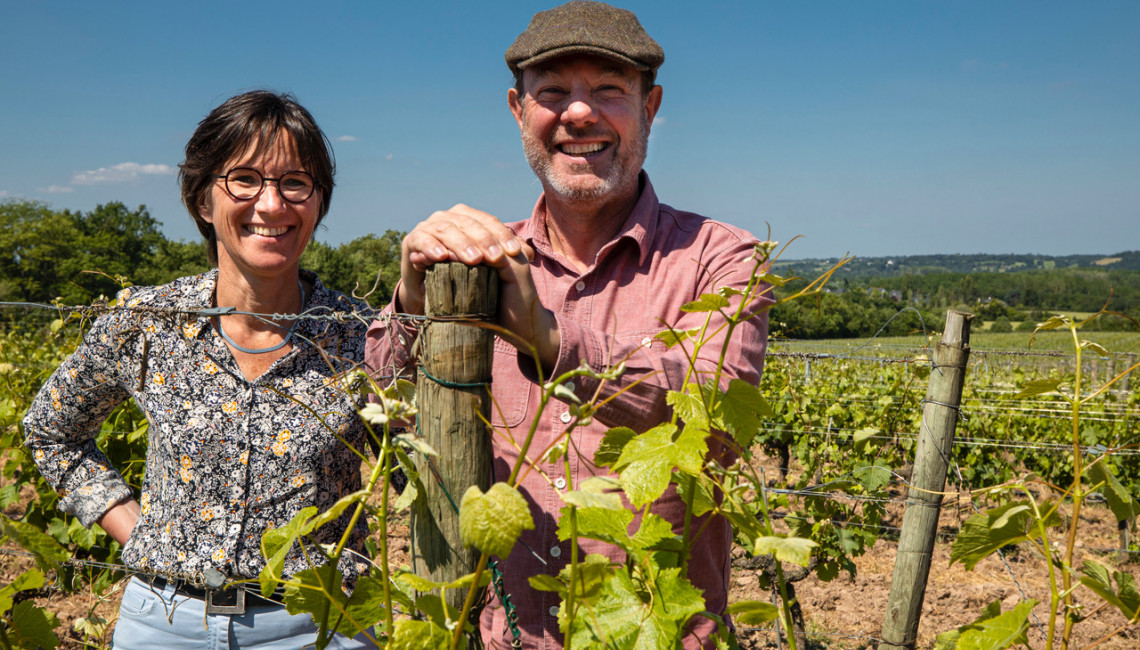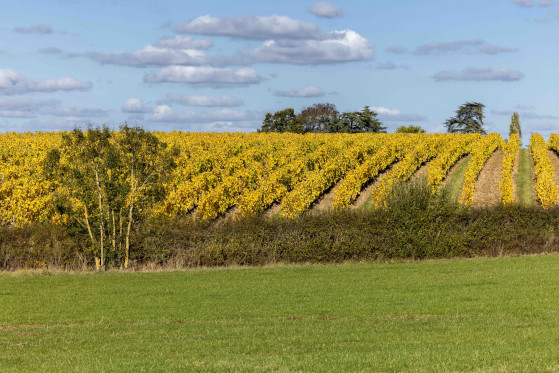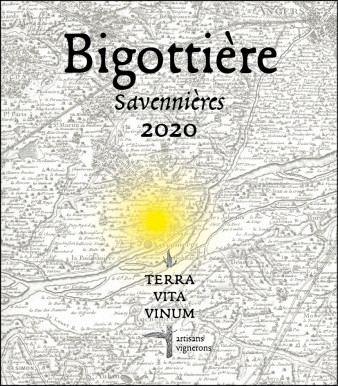In Latin means EARTH...: the history of the domain and the presentation of the vineyard.
Terra
History of the domaine


Taken over from the Richou family by Bénédicte & Luc Briand, a wine-mad couple, Terra Vita Vinum was born of a combination of passions.
Long before we took over the estate, we already shared some strong values, in particular those of Michel Legris of the french Revue Le Rouge et le Blanc: ‘It is quite obvious that oeno-technological aromas, at once tautened and amplified by SO2, defined and simplified by an arsenal of yeasts or aromatic enzymes and the result of a whole kitchen which, one moment, cools, the next moment heats, then gums, sticks, filters, stabilises at all costs etc., these aromas are a matter for the winemaker. ... these aromas are simplistic and sensory violence that have much more to do with the aesthetics of modern agri-foodstuffs than with the way in which wines that are both freely produced and protected from pernicious deviations create an aromatic landscape that we love’.
As a result, when we prepared our first harvests here, we were already living these values and, as time goes by, our roadmap has become even clearer in terms of structuring our passions:
Passion for the terroir
Luc is a native of the region. And it was the terroir that greatly influenced our choice of this estate. The proximity of the Loire, Aubance and Layon rivers, as well as the different types of schist and volcanic rock found in this part of Anjou Noir, appealed to us. To better reflect all these differences, we have identified numerous terroir units. We want to make the most of them by highlighting them through our multiplication of parcel-based cuvées, as the Burgundians have been doing for a long time with their climats.
Passion for the vine
As we often say, the harvest is the fruit of a year's work in the vineyard. It is on this basis that we wish to give our vineyard a guideline. Indeed, if you want to produce a great wine, we are convinced that you need to have a taste for working the vines, while respecting the different terroirs that make up the vineyard. We work in harmony with nature, taking into account the vegetative rhythm of the vine and the biodiversity that we develop and maintain day after day. This is also why we use a certified biodynamic approach, respecting the lunar calendar. It's the famous common sense that accompanies us every day, and above all it's not the desire to divert people's minds in order to turn tables!
Our plantations are based on highly diversified massal selections. This enables us to avoid the trap of genetic standardisation and deliver superior aromatic complexity, while perpetuating a varietal diversity that is closer to our values. In terms of cultivation, we use no chemical inputs and no weedkillers. We use natural plants to protect the vines. When it comes to working the soil, we adopt a selective approach, depending on the terroir, the grape varieties and the climatic conditions. We always seek to protect the life of the soil. Depending on the plot, we keep inter-row cultivation to a minimum to encourage environmental biodiversity and use flora and fauna as crop aids. Without forgetting that the aim is always to make wine. Our short pruning method respects the flow of sap. On our plots, green harvesting includes very meticulous disbudding and between-the-hearts pruning. Depending on the plot, pruning is rare and late, or even replaced by braiding the shoots on the last wire.
We are gradually introducing animals into the vineyards. One plot is worked by horse and we also use miniature cows to mow the grass in the vineyards in autumn and winter, enriching the soil with organic matter.
It's for all these reasons that we don't buy grapes, we only make wine from those we grow.
This approach does not prevent us from having our doubts. We share the sentiments of Alain Aspect - winner of the Nobel Prize in Physics in 2022 - when he said ‘failure is part of the job, and sometimes discouragement too’. As the causes of a vintage's quality are multi-factorial, we are convinced that each harvest will always deliver surprises that will have to be dealt with on a case-by-case basis. With this in mind, we often call on the ‘skills club’ of ‘biodynamic’ winegrowers and the Raw Wine community, in the firm belief that sharing experiences helps us to grow.
Passion for terroir wines
Our greatest emotion when tasting wine is linked to four factors that we believe to be essential: the nose, the ‘feel’ of the mouth, the precision and the energy that emanate from the wine. To achieve this, we protect the juices as naturally as possible. We also strive to use long ageing periods to enhance complexity and deliver wines that are ready to drink.
In line with our biodynamic specifications, we limit inputs to a minimum in the cellar, in harmony with our work in the vineyard. We are uncompromising when it comes to harvesting parcels of land, by hand of course.
For white wines made from plot-based cuvées, the first selections are made on the vine. We then prefer to harvest the grapes in open-work mini-trays weighing only 8/10 kg, to feed the press with firm grapes that have no juice. Pressing cycles are long. For our Bigottière, Grandes Rogeries and Pavillon cuvées, after settling, the juices are racked into their micro-oxygenation containers (barrique, concrete egg and amphora) for a period of 2 years. Other plot-based cuvées are aged for 12 months.
For red wines, the same care is taken. Depending on the soil, grape variety and vintage, we may or may not start cold maceration, with or without whole bunches, in order to restore freshness and luscious fruitiness. Our style of winemaking for the reds is to emphasise finesse and elegance rather than power and extraction.
For Jules Chauvet, terroir is 45% soil and 55% indigenous yeasts. So we have to grow our yeasts in the vineyards (not in a laboratory) to encourage the annual expression of the terroir. Working with our indigenous yeasts from the year's grapes is a stressful exercise for us, but beneficial for the wine. No sulphites are used on the harvest in order to respect the aromatic complexity of the juices.
To protect the fruit and the precision of our time-consuming work, we use very small doses of sulphite at bottling if necessary. As far as possible, we finish maturing the wine in bottle for at least half of the time spent maturing it in the cellar. With this in mind, a plot-by-plot cuvée is released around 3 years after harvesting. All in all, if we include the year in which the vines are cultivated, it takes 4 years of work to produce a new vintage. It's a bit crazy, but we're proud of it!
In conclusion, we hope that the respect we have for the vines and the winemaking process will be a source of unique emotions when tasting each of our cuvées. As Ted Lemon of Littorai Wines likes to say, ‘The job of winemakers is to make wines that are the most honest and crystalline expression of their place of origin, and then let others decide if they think their efforts are worthy of consideration’. We largely share this position.
Luc & Bénédicte
The vineyard

The domaine is rather well diversified geographically and is structured around « seven different terroirs » :
- Bigottière (white wine from Savennières) ;
- Pavillon (white wines) ;
- Gabouchons/Violets (white and red wines) ;
- Rogeries (white wines) ;
- Grand Vau(white wines) ;
- Châteliers/Chant de la pierre (red wines) ;
- Chauvigné (white, rosé and red wines).
This diversification makes it possible to distribute the climatic hazards but also to multiply the mineral expressions of the geological characteristics of each of these seven parcels.

The vineyard, with a surface area of about thirty hectares, is located in the part of the Anjou Noir region of the Loire Valley, south of Angers. Unlike the Saumur region known as the white Anjou and characterized by its limestone soils which correspond to the Parisian basin, the Anjou noir with its dark rocks (schists, gneiss, rhyolites and granite), corresponds to the Armorican massif. And it is precisely this characteristic that gives wines a pronounced and unique character. The Anjou noir is a shale land. Fabrice Redois, geologist, lecturer at the UFR Sciences, University of Angers, explains that the Anjou Noir is « a geological unit composed mainly of rocks that have been subjected to constraints (folds, faults, magmatic intrusions, metamorphism) related to orogenesis (mountain range formation) ».
On the wine-growing soils of the Anjou Noir, there is therefore a predominance of schists (sandstone to sandstone schists, purple schist sometimes sandstone, green-grey schist...), but also different volcanic rocks (rhyolites, spilites, phtanites,...). In 50 metres, you can travel a million years ! The diversity of the terroirs is also due to surface formations, such as wind sands or colluvium. To this can be added the influence of the Loire and its tributaries, the presence of hillsides in Anjou which are found to be adapted to the cultivation of vines, as well as the angevin microclimate - this is not a legend since it records one of the lowest rainfall rates in the Loire Valley.
Thus, the king of Angevin grape variety, chenin, feels very comfortable on the terroirs of the Anjou Noir. We have everything we need to have quality wines : the suitability of the grape variety and the soil between the chenin and the schist, the limited yields, the quality monitoring... Organic wines are not in the standard of varietal wines, we are on wines from the soil. These are lands that warm up easily, From a micro-climatic point of view, they are particularly suitable for a good maturity of Chenin, which is a late variety. The schist brings something special to the mouth, a unique style.





